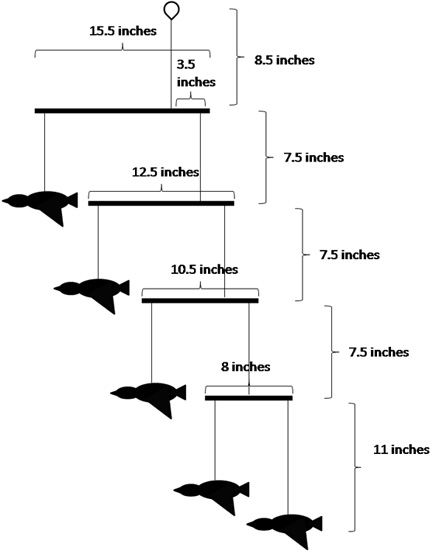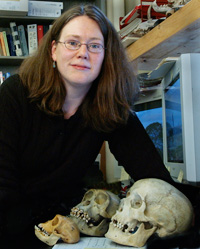
|
|
|
|||
For each of my three children, my sister’s gift to the newborn was a mobile to hang over the crib. Her first baby was born in December and it’s my turn to be auntie and to provide the mobile. Since it’s baby who spends most time looking at the mobile, my first design consideration was that it should be interesting to look at from a baby’s-eye view, below. One of my favorite spring-time activities is watching the birds as they go about the busy business of courting and nest building up in the branches of the trees in my backyard. So inspired, I composed the mobile of branches and birds for my new niece to look up at. I disguised the structural parts of the mobile as tree branches using I-cord twigs and garter-stitch leaves. From the branches, colorful birds hang by crochet chains. No two birds are alike, but they are all worked in different combinations of the same eight colors. By substituting a different palette, this mobile could fit in well with any nursery décor. I imagine a version with white birch branches, and baby pastels for the leaves and birds would look beautiful, too. You can use any combination of colors you like for your birds. This is an ideal knit-from-stash project because it uses small amounts of many different colors, and as long as they are of similar weights, they don’t need to be the same yarn. For the branch and leaf colors, 100 yards is more than enough, and for the other colors, 50 yards each is plenty. If you wanted to buy yarn for the project, you could substitute Wool of the Andes in Chocolate, Daffodil, Hollyberry and Winter Night for the Lamb's Pride, the Cascade 220, the Swish Superwash and the now discontinued Blueberry colorway, and the total project cost would be under $20, even with the dowel rod. |
|||
| SIZE | |||
One |
|||
| FINISHED MEASUREMENTS | |||
Height: approx. 42 inches |
|||
| MATERIALS | |||
Knit Picks Wool of the Andes [100% Peruvian Highland
Wool; 110yd/101m per 50g
skein]; 1 skein each color
|
|||
| GAUGE | |||
24 sts/32 rows = 4 inches in stockinette
stitch using larger (double-point) needles |
|||
|
PATTERN NOTES [Knitty's list of standard abbreviations and techniques can be found here.] |
|||
The chart at right lists the colours used for each of these parts of each bird. The pattern will refer to 'body color', 'stripe color', etc.
Crochet Cast On Jogless Stripes: Instructions for working a French Knot can be found here. Instructions for grafting can be found here. sk2p: Sl 1, k2tog, pass slipped st over. 2 sts decreased.
|
|||

|
|||
| DIRECTIONS | |||
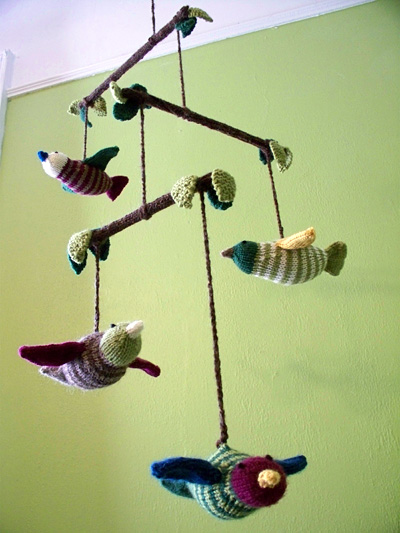 BIRD (Make 5) Tail: Body: Body is worked in 2-round stripes, using body color and stripe color. To avoid jog at beginning of each stripe, use 'Jogless Stripe' technique (see Pattern Notes). Carry yarn not in use up inside of work. When beginning a new stripe, be sure to bring the new color up from under the old color; this will twist the strands, preventing holes from forming at color-change points. Color used for each round is indicated in brackets next to round number. See color chart in Pattern Notes. Rounds 1-2 [Stripe]: K all sts. 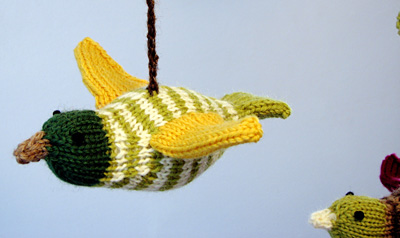 Head: Round 2: [K2, m1, k4, m1, k2] twice. 20 sts. This is a good time to embroider the eyes onto the head of the bird, as you have access to both sides of the fabric. Working approx. 2 rows back from row currently on needles, use black yarn or embroidery floss to work French knots (see schematic below for placement). See Pattern Notes for link to directions for French knots. If you haven't worked a French knot before, you may wish to practice on a swatch before you begin. Round 9: [K2, k2tog, k1] four times. 16 sts.
Shape beak to a nice point and draw yarn end to inside of head. Turning bird inside out, tighten knots, trim and secure ends as needed, leaving long tails at beginning of stripe color and body color. Turn bird right side out. Stuff head and body, but not tail. Use long tail of stripe color to sew body closed at point where body joins tail; sew top of body to bottom of body in a straight line, so that tail is flattened out at base (see photos). Sew in remaining end of stripe color. Carefully remove waste yarn from CO end, placing resulting live sts on needles; place first 12 sts one one needle, and last 12 sts on another needle. When needles are held together, tail should lay flat. Graft sts on first needle to sts on second needle. Sew in remaining end. Wings: Rounds 1-5: K all sts. Break yarn and draw through all sts, pull tight. Shape wing to a nice point and draw yarn end to inside
of piece. Weave in end, but leave long tail at beginning
of wing. Flatten wings, folding so that decrease line forms fold at one side of wing. This decrease-line fold will form back edge of wing. Use yarn tails to sew wings to sides of body (see photos), ensuring that decrease-line folds are correctly positioned toward back of bird. 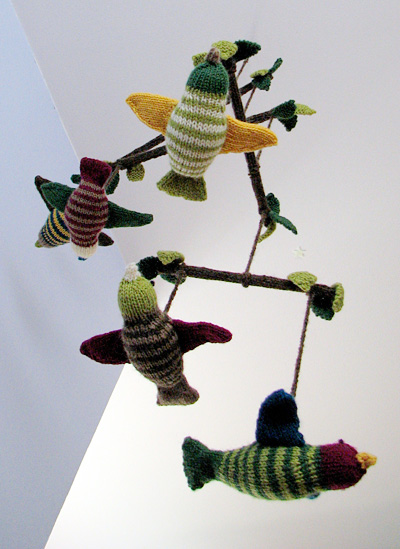 BRANCHES LEAVES Using smaller (straight) needles, CO 1 st. |
|||
| FINISHING | |||
Cut four pieces of dowel,
with the following lengths: 15 inches, 12 inches, 10 inches
and 7.5 inches. These correspond to Branches 1, 2, 3 and
4. Use attached yarn tails to sew three leaves to each end of each branch. Weave in and trim all ends. Using MC, work crochet chains of the following lengths,
leaving tails at least 4 inches long at the beginning and
end of each chain. Measure lengths of chains when stretched;
chains will stretch when piece is hung, so measuring length
when stretched will give a better indication of final results. Wrap the end of one of the mid-length chains around your index finger to create a loop at the end. Use the tail of yarn to sew the loop securely. Weave in and trim the end. Repeat for the other end of the chain. This chain, with a loop at each end, should measure approx. 8.5 inches when stretched. Form loops at each end of remaining three mid-length chains in the same way. Form a loop at one end of each short chain. Sew free end of each short chain to the back of a bird, sewing through several stitches to avoid stretching fabric out of shape. Weave in ends; be sure to try hanging bird from chain before sewing in ends, to ensure that the bird will hang in a pleasing way. Form a loop at one end of long chain, and sew remaining end to back of remaining bird. To attach the top of a chain to a branch, fold the loop at the top of the chain over, then pull some of the chain through the loop, forming an adjustable loop. (If you've ever used a yo-yo, this will be familiar to you.) Slide the adjustable loop over the end of a branch, past the leaves, then pull to tighten. In this way, assemble mobile as shown in diagram, using
mid-length chains to connect branches. After each step,
dangle the assembled piece to see if it is balanced; adjust
positions of pieces as needed. Dangle mobile to see if it is balanced; adjust positions
of pieces as needed. Once all pieces are placed and mobile
is balanced, tighten loops. These may be sewn in place
if desired, but for mobile shown, pulling the loops tightly
was sufficient to keep everything in place.
|
|||
| ABOUT THE DESIGNER | |||
Her Ravelry name is meggles and she blogs here. |
|||
| Pattern & images © 2009 Meg Bakewell. Contact Meg |

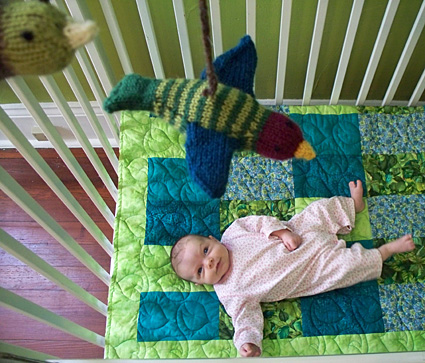
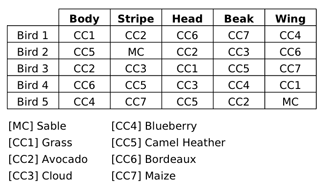
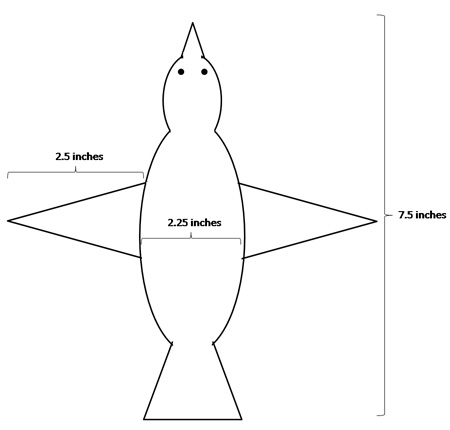 Beak:
Beak: